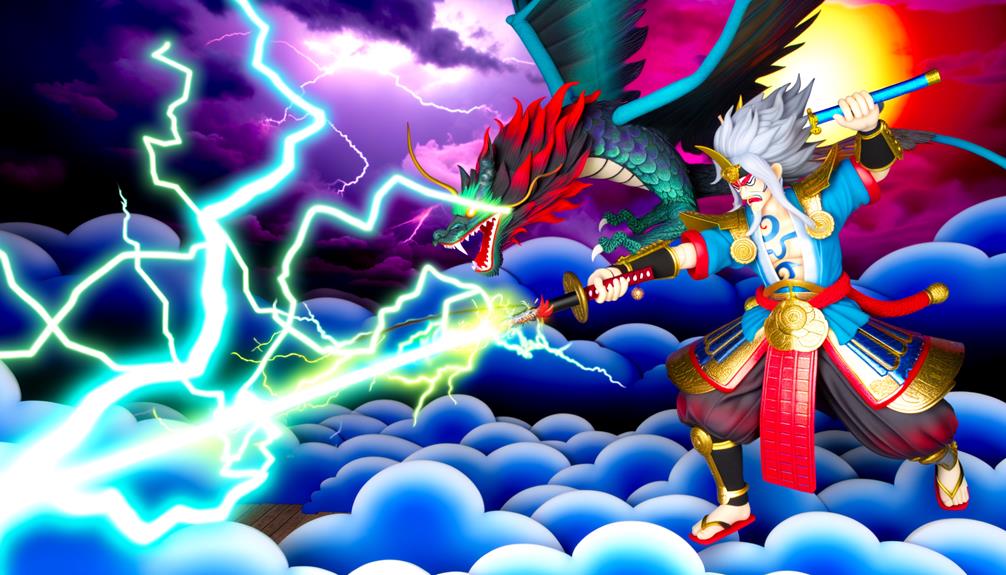If you're like most people, you might not know much about Susanoo, the Shinto god of storms and the sea. He's a big deal in Japan, especially when it comes to mythology. I'm really into this stuff, and I find the stories about Susanoo quite fascinating. They're full of bravery, disorder, and divine power. His adventures take him from battling massive monsters to journeying through mysterious worlds. All this shows how strong and brave he is. Plus, these stories don't just show him as a protective god, they also give us a peek into his relationships with other gods.
So, why should we bother about the travels of a storm god from a long-gone civilization? Well, when you get into his stories, you see that they're still relevant and influential today. They're about more than just mythology. These tales help us understand Japanese culture and society.
The Turbulent Nature of Susanoo

Have you ever wondered about Susanoo, the paradoxical deity from Japanese mythology? Born from Izanagi's nose wash, he was later exiled due to his chaotic behavior. This intriguing character, a god of the sea and storms, has a narrative steeped in traditional Japanese mythology. His unpredictable nature is a fascinating symbol of the intricate and dynamic aspects of divinity in these ancient stories.
The tale of Susanoo is a rollercoaster of chaos and transformation. Sent away for causing havoc, Susanoo sets off on a whirlwind of adventures, earning him the title of the storm god. His actions aren't always heroic – he wreaks havoc by ruining Amaterasu's rice fields. But he also becomes a savior by defeating the Yamata no Orochi, a creature causing terror to a local family. His triumph over the beast leads to the discovery of the Ame-no-Murakumo-no-Tsurugi, a sword that he gifts to Amaterasu as a peace offering.
In understanding Susanoo's stormy adventures, we get to see the fascinating duality of his character. He is both destructive and a bringer of salvation, much like the sea and storms he represents. This dual nature reflects the tumultuous yet nurturing aspects of these natural elements.
Susanoo's Heroic Deeds
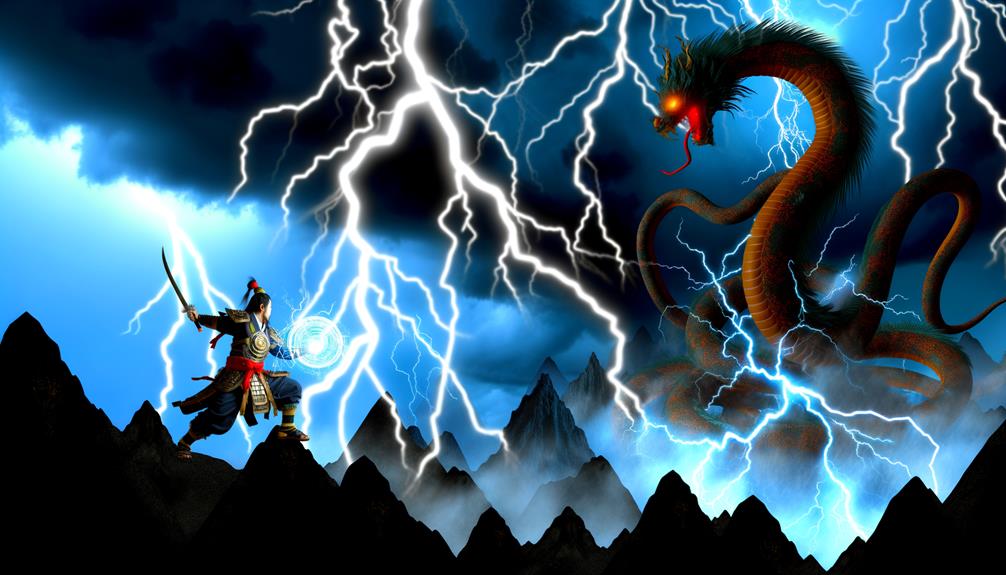
Susanoo, a character from Japanese mythology, is known for his feats of bravery. These acts showed that he could be both a troublemaker and a hero, making him a complex but fascinating figure. He came into existence when Izanagi, his father, cleaned himself after a trip to the underworld, where Izanami, his wife, lived. However, Susanoo's rowdy behaviour led to his expulsion from Heaven, causing a ruckus and disrupting the balance on Earth.
Here's a rundown of his remarkable achievements:
| Act | Description | Aftermath |
|---|---|---|
| Rescuing Kushinadahime | Defeated the fearsome snake Yamata no Orochi | Married Kushinadahime |
| Oath Challenge | Shattered his sword, producing six male gods | Demonstrated his honesty to Amaterasu |
| Giving the Ame-no-Murakumo-no-Tsurugi | Also known as the Grass-Cutting Sword | Made up with Amaterasu and returned to Heaven |
Although Susanoo was the god of storms and the sibling of Amaterasu, he had a gentler side that was evident in his brave acts. After showing his honesty, he went back to Heaven, had a face-to-face meeting with his sister, and gave her the Sword of the Gathering Clouds, marking the end of their feud. So, Susanoo's courageous acts portray him as a complicated deity who could be both a saviour and a troublemaker, a storm god and a hero.
Myths and Legends Surrounding Susanoo
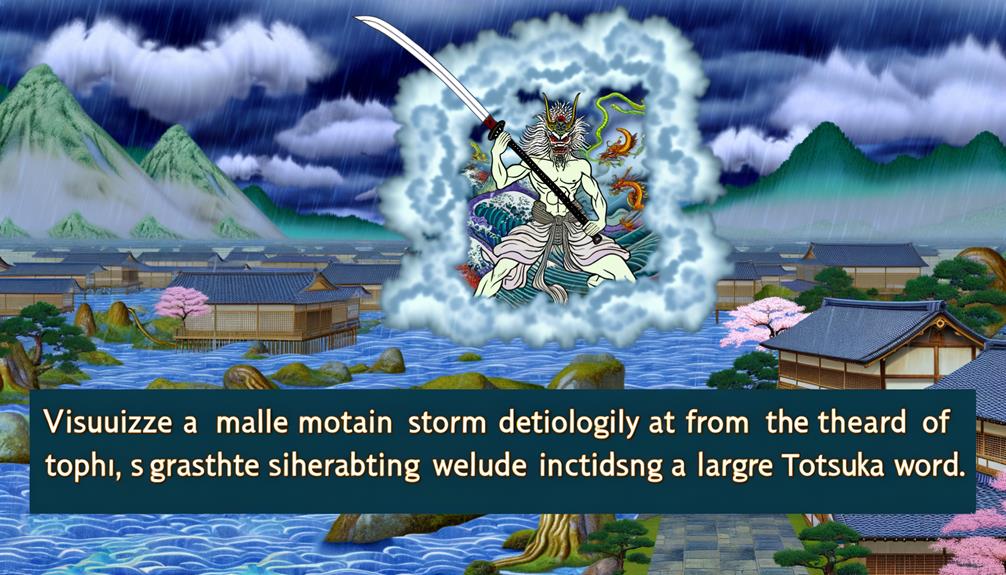
Let's take a closer look at Susanoo, a figure in Japanese mythology whose impact goes way beyond his heroic acts. This guy is a big deal in many Japanese myths, and there are even hints of connections to other cultures. His origins trace back to Izanagi's purification ritual following a visit to the underworld. Sadly, his rowdy behavior got him kicked out of Heaven. But Susanoo is more than just a banished rain god. His actions have a profound impact on many Japanese myths.
Now, let's chat about his promise to Amaterasu, the sun goddess. This resulted in the creation of more gods, which really shows how important he is. Susanoo is a pretty complex character, linked with the sea, storms, and even farming. Particularly in Shimane Prefecture, they really celebrate his achievements. Take, for example, his heroic rescue of Kushinadahime from Yamata no Orochi. That's something right out of a legend!
Susanoo gave the Ame-no-Murakumo-no-Tsurugi sword to Amaterasu, one of the Three Precious Children. This sword is now part of the Imperial Regalia, showing us just how vital Susanoo is to the Soshimori, the spiritual backbone of the imperial family. These stories about Susanoo not only show how complex he is, but also hint at connections to the Korean Peninsula. Understanding this helps us appreciate the importance of this god in a broader context.
Cultural Significance of Susanoo
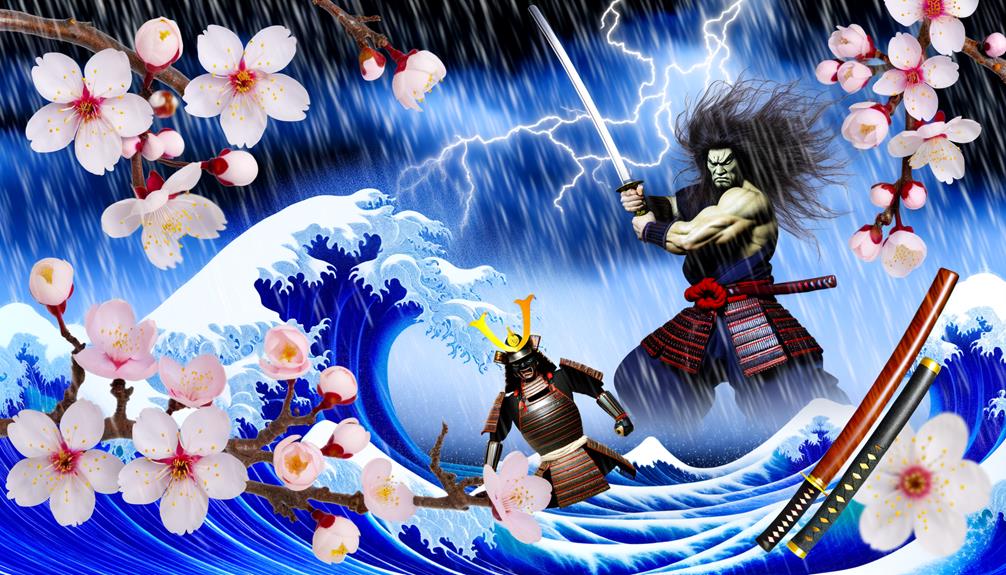
To really understand the cultural impact of Susanoo, it's necessary to delve into his various roles. He was more than just a god of sea, storms, fields, and agriculture. He was also tied to pestilence and disease in the mixed faiths of the Gion cult. In the divine world, called 68, Heaven, Susanoo was a god of both chaos and creation. His tale brings us to Soshimori, a place in western Japan, where he encountered an elderly pair with three kids. This is where his true intentions for coming to Earth become apparent.
During a conversation, Wo no Mikoto made a point that all gods need to serve a purpose. Susanoo's purpose was complex – he was meant to bring both chaos and prosperity. His actions led his elder sister, the Sun-Goddess, to declare that he was causing too much trouble and had to leave immediately. This banishment set the stage for his heroic adventures, one of which was defeating the serpent Yamata no Orochi. In this way, Susanoo's cultural impact is found in his two-sided nature as both a disruptor and a hero. This duality showcases the unpredictable side of nature and the strength of the human spirit.
Susanoo's Influence on Japanese Performing Arts
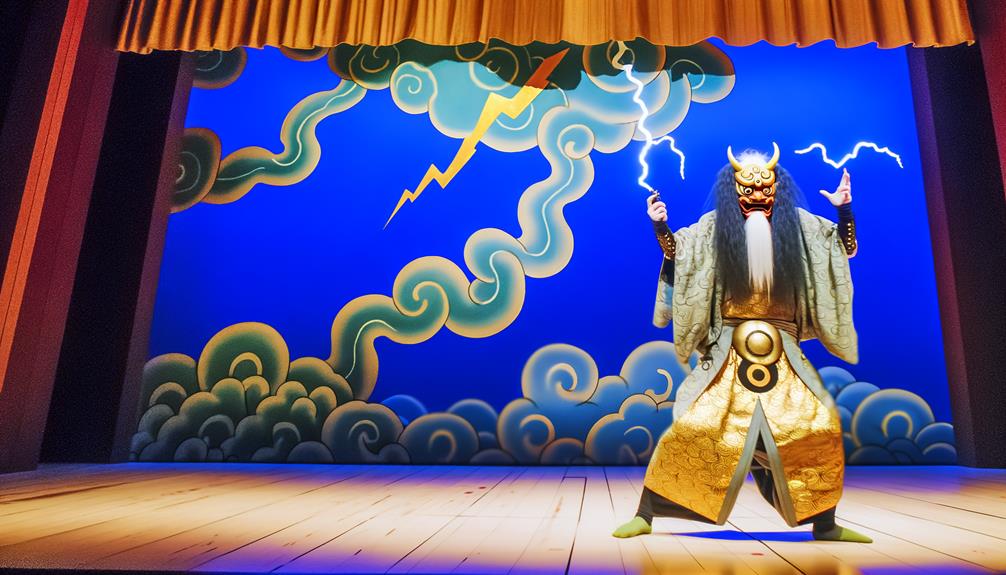
When we take a look at Japanese performing arts, we see how the heroic deeds and turbulent relationship of Susanoo with Amaterasu have left a significant mark on traditional Noh and Kabuki theater. The 'Susanoo Storm God Adventures' are often used as the foundation for intricate stories and theatrical performances.
- The ongoing battle between Susanoo, the storm god, and Amaterasu, the undisputed leader of the heavenly gods, is a theme that comes up again and again. The peak of their fierce sibling rivalry, when Susanoo shattered Susanoos and suggested a competition, is frequently dramatized.
- Another favored theme is the 'Gathering Clouds' episode, where Amaterasu dresses in war gear to face Susanoo. This symbolizes the struggle between order and chaos.
- Ame no Uzume, the goddess of food, played a part in calming Susanoo's anger with her dance. This is often seen as one of the earliest references to the dance performances in Kabuki.
- Susanoo's ties to Shimane Prefecture, the place he descended, are regularly celebrated in the local traditional arts. This adds a geographical aspect to his legend.
These stories provide deep understanding into Japanese performing arts, enriching them with mythological undertones and cultural references.
Frequently Asked Questions
Is Susanoo the Storm God?
Absolutely, Susanoo is the storm god you're thinking of. He's quite a character, noted for his unpredictable nature, courage, and prominent role in the tales of Japan. His story is a rather intriguing one, full of adventures after he was banished from his celestial home to our world.
Who Is Susanoo Married To?
So, you're asking who I, Susanoo, am married to? Well, let me tell you, my wife is the stunning princess Kushinadahime. I had the honour of saving her from the terrifying clutches of the eight-headed beast known as Yamata-no-Orochi. Our marriage is a pretty big deal in Japanese mythology. It not only resulted in the birth of a host of deities, but also led to the finding of the renowned Kusanagi-no-Tsurugi sword. Quite the thrilling tale, isn't it?
Is Susanoo a Male or Female?
Sure thing, Susanoo is indeed a male. If you're into Japanese myths, you've probably heard of him. He's a big deal in those stories, often shown as a mighty storm god. This guy's known for his quick-tempered character and his skill in battle. In a nutshell, Susanoo represents chaos and the force of the ocean.
What Does Susanoo Use to Create 5 Gods in His Competition With Amaterasu?
So, you're curious about what Susanoo used to create five gods in his friendly rivalry with Amaterasu, right? Well, he cleverly used strands of magatama beads. Picture a sculptor molding clay into beautiful forms. That's exactly how Susanoo crafted five male deities. This act wasn't just for show; it revealed the awe-inspiring ability to transform that these divine beings possess.

